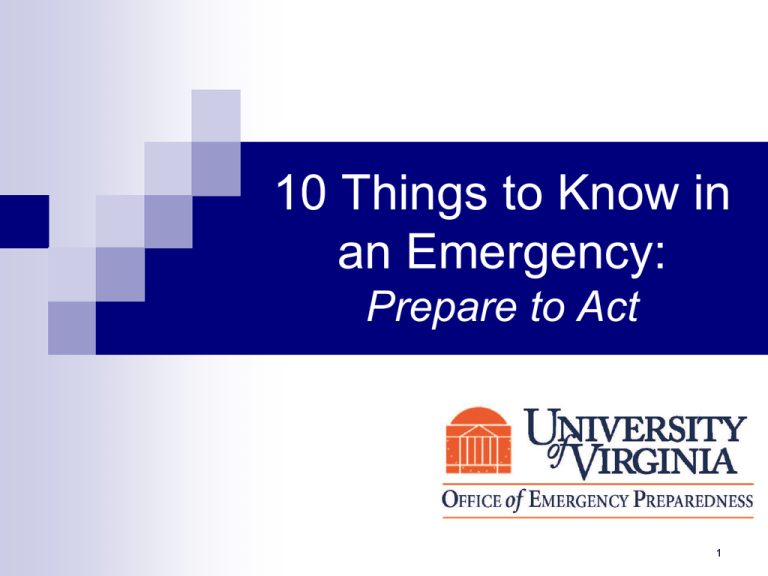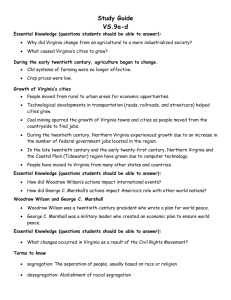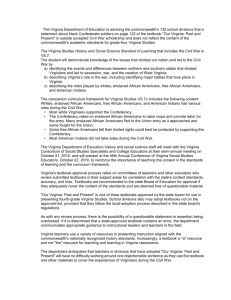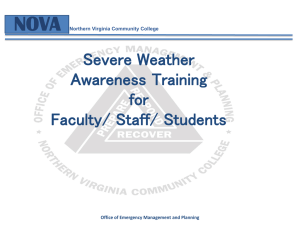10 Things to Know in an Emergency
advertisement

10 Things to Know in an Emergency: Prepare to Act 1 Emergencies can happen at any time… 2 Preparing in advance allows you to respond quickly and safely It will help to know: Your work space and what emergency resources are available How you’ll hear about an emergency How to get help What decisions you may have to make How to evacuate and how to shelter in place Who your emergency contacts are and how to contact them How to stay informed 3 1. Know your space & equipment Know your building: Exit routes Areas of rescue assistance Shelter in place locations Assembly location Know your gear: First aid supplies Automatic External Defibrillator (AED) Emergency Procedures poster Keep a Go Bag (flashlight, emergency contacts, etc.) 4 2. Hearing about an emergency UVa Alerts LCD or LED displays Siren Fire alarm News media Alerted by a colleague Call from a friend Witness the event 5 3. Getting help For any type of emergency call 911* Give your name, address, and the nature of the emergency Stay on the line until you are told you may hang up Remain calm and answer questions as clearly as possible * Health System calls 4-2012 6 4. Deciding what to do Gather information Watch and listen for instructions Follow instructions Shelter in Place = Stay Evacuate = Go Sometimes you just have to use your best judgment 7 5. Evacuating Secure hazardous materials or equipment Take personal belongings and emergency kit* Close, but do not lock doors Walk to the exit in an orderly manner; do not use the elevators Assist persons with disabilities or special needs If unable to exit the building, move to the designated areas of refuge Once outside, check in at the assembly area Wait for approval to re-enter 8 6. Sheltering in place Secure hazardous materials or equipment Grab your emergency kit Move to the shelter location; bring visitors/guests Close and lock the door Turn on emergency radio to stay updated* Check in with the person in charge Check in with family emergency contact, then stay off the phone Wait for approval to leave the shelter location 9 7. Emergency contacts Personal Spouse/significant other/emergency contact School Eldercare Out of area contact Professional Manager Colleagues Interdependent organizations 10 8. Staying informed University home page (www.virginia.edu) University emergency home page (emergency.virginia.edu) Closings and Delays lines 243-7669 (SNOW) 924-7669 (SNOW) Your unit’s communication channels 11 8. Staying informed (cont.) In severe weather situations – rely on local television and radio stations EAS Radio Stations EAS TV Stations WCHV/WWWV 1260 AM/97.5 AM WVIR Channel 29 WINA /WQMZ 1070 AM/95.1 FM WCAV Channel 19 WKAV 1400 AM WVAW Channel 16 WUVA 92.7 FM WAHU Channel 9 WCYK 99.7 FM WVSY 101.9 FM WVAO 102.3 FM Community emergency page (www.communityemergency.org) 12 9. Recovery An extended disruption may require continuity of operations (COOP) efforts COOP team members perform essential functions during critical events Learn about your unit’s COOP plan Understand if you are ‘designated’ or ‘nondesignated’ If you are designated, know your roles and responsibilities; plan accordingly for your family’s needs If you are non-designated, know what is expected of you and how you should stay informed about the return to normal operations 13 10. Practice and Update Practice On a regular schedule, talk through an emergency scenario with your team Evacuate with every fire alarm Move to the shelter in place location during the statewide tornado drill Update Keep up to date on local hazards Make sure emergency contacts are current Reflect staff changes & building changes in your plan 14 Additional resources University of Virginia Emergency Information http://www.virginia.edu/emergency/ Office of Emergency Preparedness http://www.virginia.edu/emergencypreparedness/ Critical Incident Management Plan http://www.virginia.edu/emergency/plan.html Virginia Department of Emergency Management www.vdem.state.va.us Ready Virginia www.readyvirginia.gov Red Cross www.redcross.org 15 Questions? Office of Emergency Preparedness uvaoep@virginia.edu (434) 982-0565 Marge Sidebottom – mls9m@virginia.edu Kirby Felts – kfelts@virginia.edu Terry Tigner – tbt8k@virginia.edu 16











